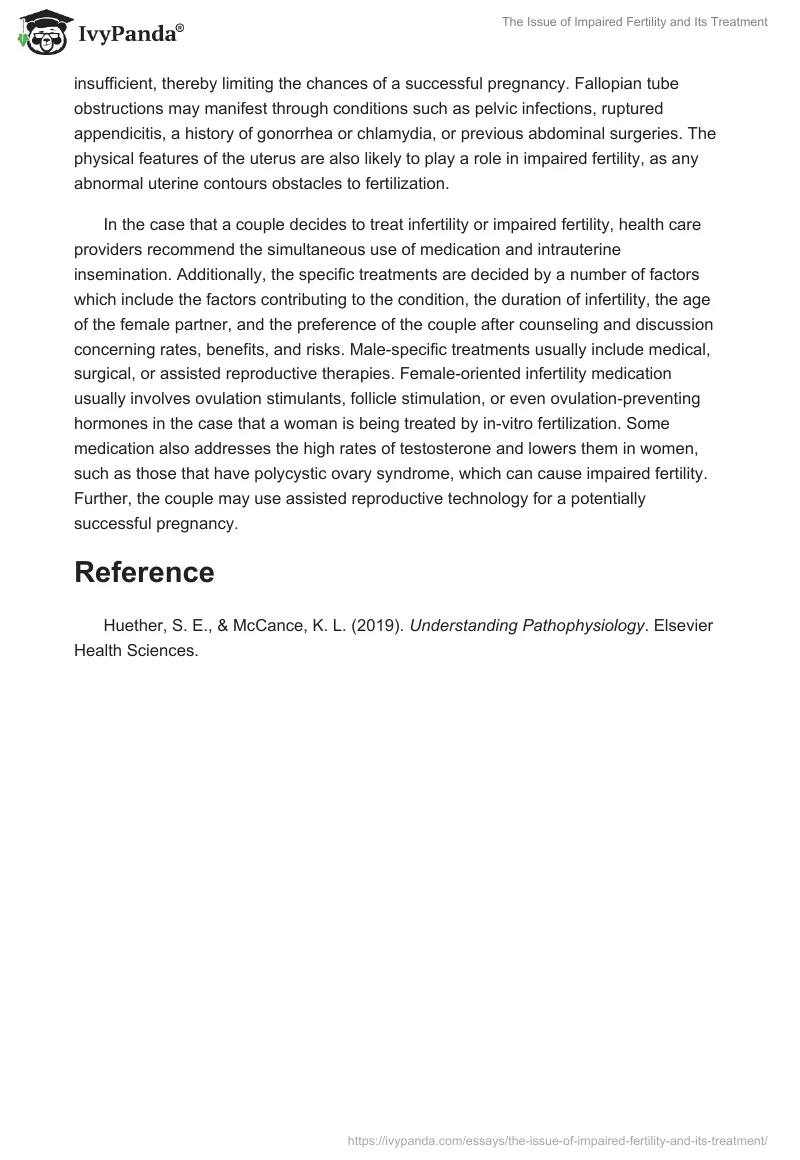Infertility or impaired fertility can be defined as the inability to become pregnant or conceive within the timeframe of one year as a result of unprotected sex. Due to the fact that fertility may become impaired with age, health care providers usually treat women according to this decline after the age of thirty-five and within six months of unprotected sex. Impaired fertility may manifest at a number of stages of a typical pregnancy. Because a pregnancy requires the release of an ovum, fertilization by a sperm, and attachment of an embryo to the inside of the uterus, a number of factors may be responsible for infertility or impaired fertility. Impaired fecundity refers to a condition that relates to infertility but is specific to women who have challenges becoming pregnant or carrying pregnancies to term. Currently, infertility and the inability to conceive affect approximately 15% of all couples (Huether & McCance 807). Additionally, factors that influence infertility may be due to issues in the female pregnancy process, the reproductive system of the male partner, or even in both partners. Within women, around 6% between the ages of fifteen and forty-four can be affected by infertility, while impaired fecundity affects about 12% of the same population.
Because infertility is an issue that may also be a result of conditions in the male partner’s body, cases of impaired fertility are not only a problem faced by the female partner. Some of the ways in which pregnancies may be impeded by male conditions include the disruption of testicular or ejaculatory function, hormonal disorders, or genetic disorders. Many of these conditions cause either the lack or under-production of sperm. Some conditions may even alter the shape of the sperm, which may result in impaired fertility.
Within women, female infertility may occur as the effect of dysfunctions within regular reproductive processes. These can include menses, ovulation, fallopian tube operations, ovarian dysfunctions, or incorrect implantation of a fertilized egg within the receptive endometrium. Disruptions to the ovarian system can include polycystic ovary syndrome, limited ovarian reserves, menopause, premature ovarian insufficiency, or even functional hypothalamic amenorrhea. The aforementioned conditions often affect the ways in which hormones and ovarian reserves can become ineffective or insufficient, thereby limiting the chances of a successful pregnancy. Fallopian tube obstructions may manifest through conditions such as pelvic infections, ruptured appendicitis, a history of gonorrhea or chlamydia, or previous abdominal surgeries. The physical features of the uterus are also likely to play a role in impaired fertility, as any abnormal uterine contours obstacles to fertilization.
In the case that a couple decides to treat infertility or impaired fertility, health care providers recommend the simultaneous use of medication and intrauterine insemination. Additionally, the specific treatments are decided by a number of factors which include the factors contributing to the condition, the duration of infertility, the age of the female partner, and the preference of the couple after counseling and discussion concerning rates, benefits, and risks. Male-specific treatments usually include medical, surgical, or assisted reproductive therapies. Female-oriented infertility medication usually involves ovulation stimulants, follicle stimulation, or even ovulation-preventing hormones in the case that a woman is being treated by in-vitro fertilization. Some medication also addresses the high rates of testosterone and lowers them in women, such as those that have polycystic ovary syndrome, which can cause impaired fertility. Further, the couple may use assisted reproductive technology for a potentially successful pregnancy.
Reference
Huether, S. E., & McCance, K. L. (2019). Understanding Pathophysiology. Elsevier Health Sciences.


